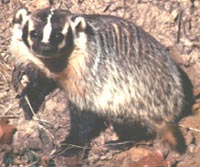Badger (Taxidea taxus)

TPWD ©
- Description
- The badger is a very robust and stocky animal with a short, bushy tail. It has a comical walk since it has to swagger or waddle because of its short legs and broad body. It has long, shaggy fur with a very distinctive white stripe that extends from its nose to its shoulders. The badger's black feet each have five toes, and the front feet have long, thick claws an inch or more in length. Badgers have small eyes and ears and a slightly pointed nose. Their keen sense of smell is second only to that of members of the dog family. Although they look cute and shy, badgers are ferocious fighters that should not be disturbed. They will growl, snarl and emit an unpleasant musk scent if provoked.
- Life History
Badgers are fossorial animals, which means they burrow underground. When excavating, badgers use their long, thick front claws to break fresh ground while their back legs kick out the excess dirt. They are known to dig faster than any mammal, including a man with a shovel. Badgers primarily eat small mammals such as ground squirrels, pocket gophers, prairie dogs and cottontail rabbits, but they also will consume birds, invertebrates and carrion. Badgers also eat rattlesnakes and, luckily for them, they are unaffected by the snake's venom unless they are struck on the nose. While hunting burrowing animals, badgers are occasionally out-maneuvered by "wily" Coyotes. As badgers dig after rodents, Coyotes will wait and snatch the escaping prey above ground, leaving badgers with just a glimpse of what might have been for dinner.
Badgers usually den in shallow burrows except during breeding season, when they will dig a nest chamber deep below the ground. These "badger holes," called setts, are evidenced by the large amounts of mounded earth that surround them. Badgers usually are solitary creatures except when they breed late in the summer. Due to delayed implantation and development, the one to five pups are not born until March or April although the actual embryonic development of the pups takes only six weeks. The female cares for the blind and helpless pups by herself until they are grown and leave the den site late in the fall. Badgers normally may live for 10 to 12 years.
- Habitat
- Badgers live in a variety of habitats, but they most commonly are found in open country such as prairies and plains. They avoid heavily wooded areas andhabitats with rocky soils.
- Distribution
- They occur west of the Great Lakes region throughout the Great Plains and Rocky Mountains. Locally, they are most common in portions of West and South Texas although they occasionally are sighted in the eastern part of the state.